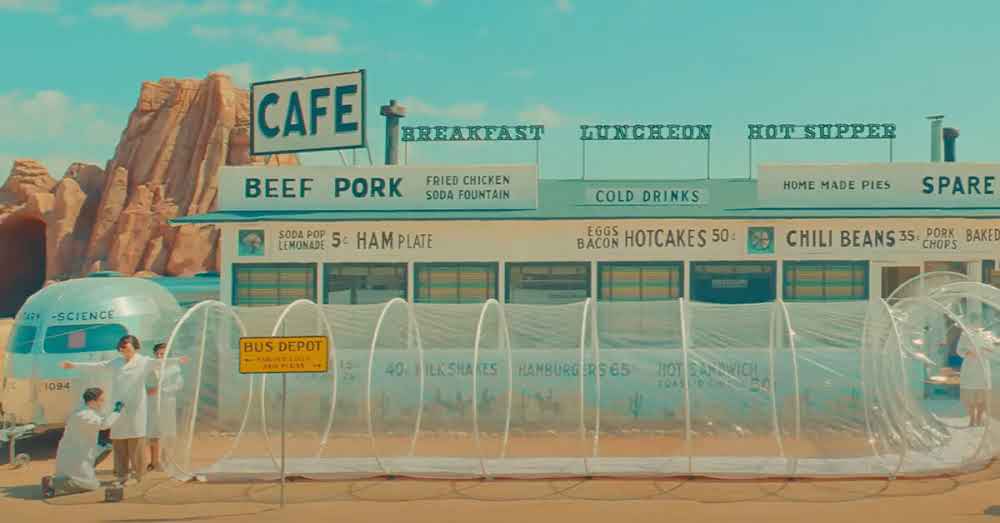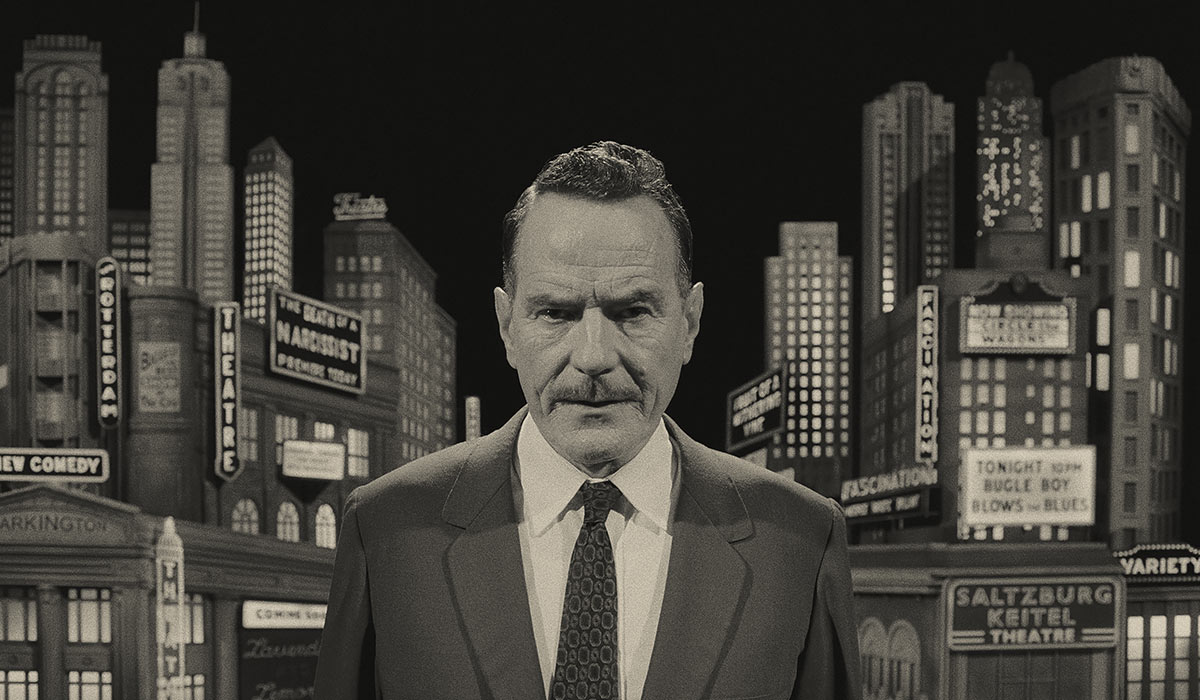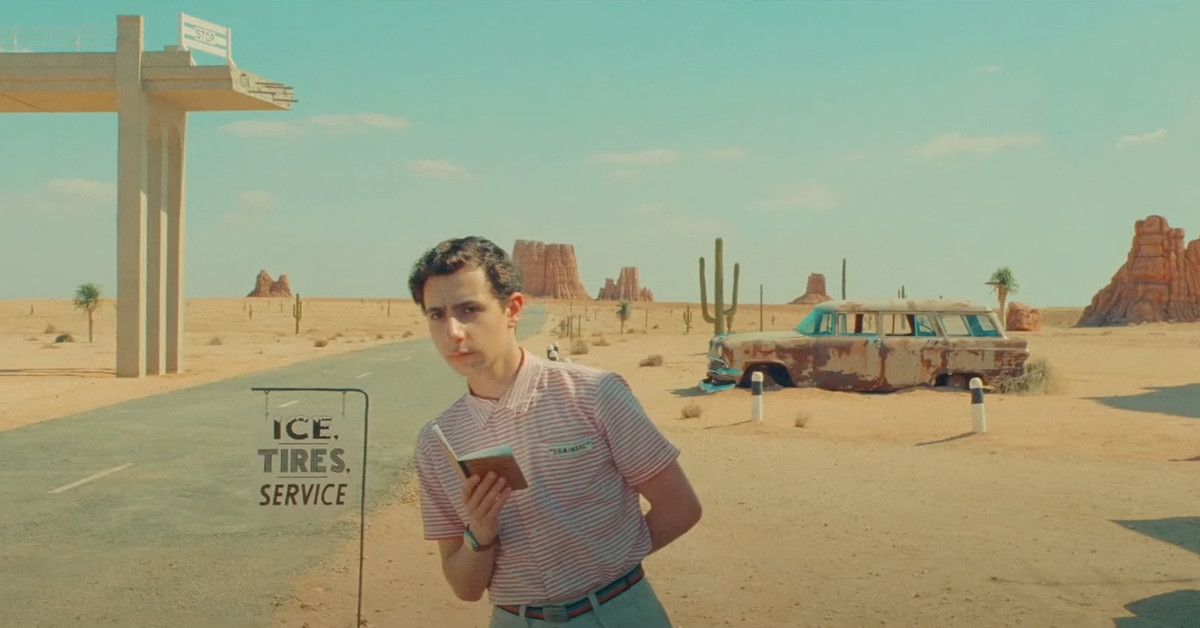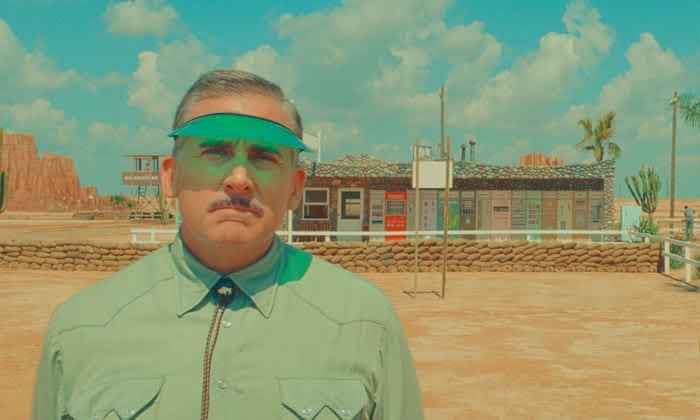There are things you’d say are likely to interest Wes Anderson, and things you reckon probably wouldn’t. His “same style, different setting” approach to filmmaking fetishises similar objects and sorts of production design, tweaking and individuating them just enough to defang the critics who accuse him of making the same movie over and over again. A film called Asteroid City would seem to challenge those apparent limitations to Anderson’s interests. Even if you didn’t assume it took place in outer space – it doesn’t – you probably would assume that it has its basis in science fiction, not an obvious match for Anderson’s sensibilities as we’ve come to know them.
If you then found out – and watching the trailers would make this easy enough to divine – that Anderson’s 11th feature was set in a small American desert town in the 1950s, made “famous” for the asteroid that struck its surface in 3007 B.C., leaving a crater, which is also the current home to about seven immaculate period buildings, a highway on-ramp that goes nowhere, and a convention for young stargazers, the Anderson-ness of it all starts to take definitive shape. And the shape of Asteroid City, on the whole, is one of the more satisfying Anderson projects to come along in years.
Let’s be clear, though – if you are out on Anderson, you are going to be out on Asteroid City. The details are typically precious. The dramatis personae is typically large and ungainly. Film stocks and aspect ratios alternate, and there’s a Russian nesting doll narrative structure that we’ve seen in The Grand Budapest Hotel and The French Dispatch in the last decade alone.
It’s reasonable to assume, though, that Anderson is no longer making films for people who are out on him, if he ever was. So in conveying how good one of his films is, we’re really addressing the people who are open to what a Wes Anderson film is, and within that openness have a history of embracing some films while rejecting others. Then again, Anderson is a bit like the Coen brothers in that way, in that all the films exceed the bar for craftmanship and distinctive vision, yet some speak to you while others don’t.
The colour portion of Asteroid City is a play about the titular town during a particular 24-hour period and the events a week after it, as explained to us by a narrator in the black-and-white portion (Bryan Cranston), and a listing of acts and scenes that regularly appears on screen. The narrator’s “world” is a television show about the making of the play, in the same period. It’s really not as complicated as it sounds, which for a baroque filmmaker like Anderson is a high compliment.
The characters we’re going to be focusing on start with a war photographer, played by Anderson regular Jason Schwartzman, whose wife has just died after a long illness – a fact he has not yet revealed to his three little girls and an older son nicknamed Brainiac (Jake Ryan). They’re stranded in Asteroid City after car troubles on their way to visit the kids’ grandfather, played by Anderson first-timer Tom Hanks. But they’d also been planning to return to Asteroid City since Brainiac is attending the stargazer convention, along with about four other brilliant teenage achievers who are all receiving awards for various inventions. The mother of one is a famous actress (Scarlett Johansson). In the mix also are a motel manager (Steve Carell), a mechanic (Matt Dillon), a military general and the host of the convention (Jeffrey Wright), and parents of the other kids (Hope Davis, Liev Schreiber and Stephen Park).
However, to get the full scope of Anderson’s ambitions, you do have to pull out one step further to the black-and-white version, in which some of these same actors appear as the actors playing the characters in the play. Here you also have the playwright (Edward Norton), the director (Adrien Brody) and the actress playing the kids’ dead mother (Margot Robbie). Among, of course, many others.
The potential for the worst kind of Anderson freneticism rears its head, but never arrives, thanks to the wonderful Asteroid City set that immediately puts you in a specific time and place of Americana and nostalgia. It helps that the release of Christopher Nolan’s Oppenheimer has put us all in a mid-century southwestern head space, and indeed, we see atomic bombs being test detonated in the Asteroid City background. Barbie may have made a counterintuitive pairing as a double feature with Oppenheimer, but Asteroid City is what a festival director would actually program as a thematic partner with a tonal shift.
Anderson’s scant set of buildings – introduced lovingly near the start, after the camera rides in on a train and then spins around the town, taking it all in – has an explanation for its sense of artificiality, in that we are supposed to be watching a play. Of course, it doesn’t feel two-dimensional, only suggestive of what would necessarily be a larger infrastructure to support even the town’s tiny population of 87. When we’re in Anderson’s mind, it’s not realism we’re seeking. It’s a pop art world whose truth emerges from the people within it and the real, relatable melancholy they suffer.
And here Anderson does not disappoint. Schwartzman’s Augie Steenbeck is like an echo two decades later of the character Ben Stiller played in The Royal Tenenbaums, looking after a brood of children in the wake of his wife’s death, his real pain temporarily obfuscated by Anderson’s technique until it springs itself on unsuspecting viewers at the most potent moment. He develops a kinship with Johansson’s Midge Campbell, who confesses to a self-absorption that has placed her career first and her daughter (Grace Edwards) second. Anderson nestles these and other minor tragedies within his larger framework of eccentricity and laugh-out-loud wordplay.
The action on the Asteroid City set is note perfect, and is so good that it elevates the picture despite the black-and-white TV portions lacking the same sense of urgency. Those sections do at least serve the function of placing us comfortably within Anderson’s usual degree of narrative difficulty, without which it wouldn’t seem as much like one of his films. (Plus they contain the bits by Cranston as the narrator/host of this TV show, which are hilarious.) Among the first-time Anderson collaborators, there’s a real range of effectiveness, from Hanks falling naturally into the Anderson rhythms, to Carell grinning and seeming too self-conscious by half, with Dillon landing somewhere in the middle.
The overwhelming effect of all this content, though, is to weaken any instinct to nitpick Asteroid City, just as you refuse to poke holes in any personal favourite that might have glaring flaws. Even Steve Carell is not a glaring flaw, and you wouldn’t risk substituting Bill Murray or Owen Wilson or any other Anderson regular who isn’t present if it might have made the film even a smidgen less than it is.
Asteroid City is currently playing in cinemas.




